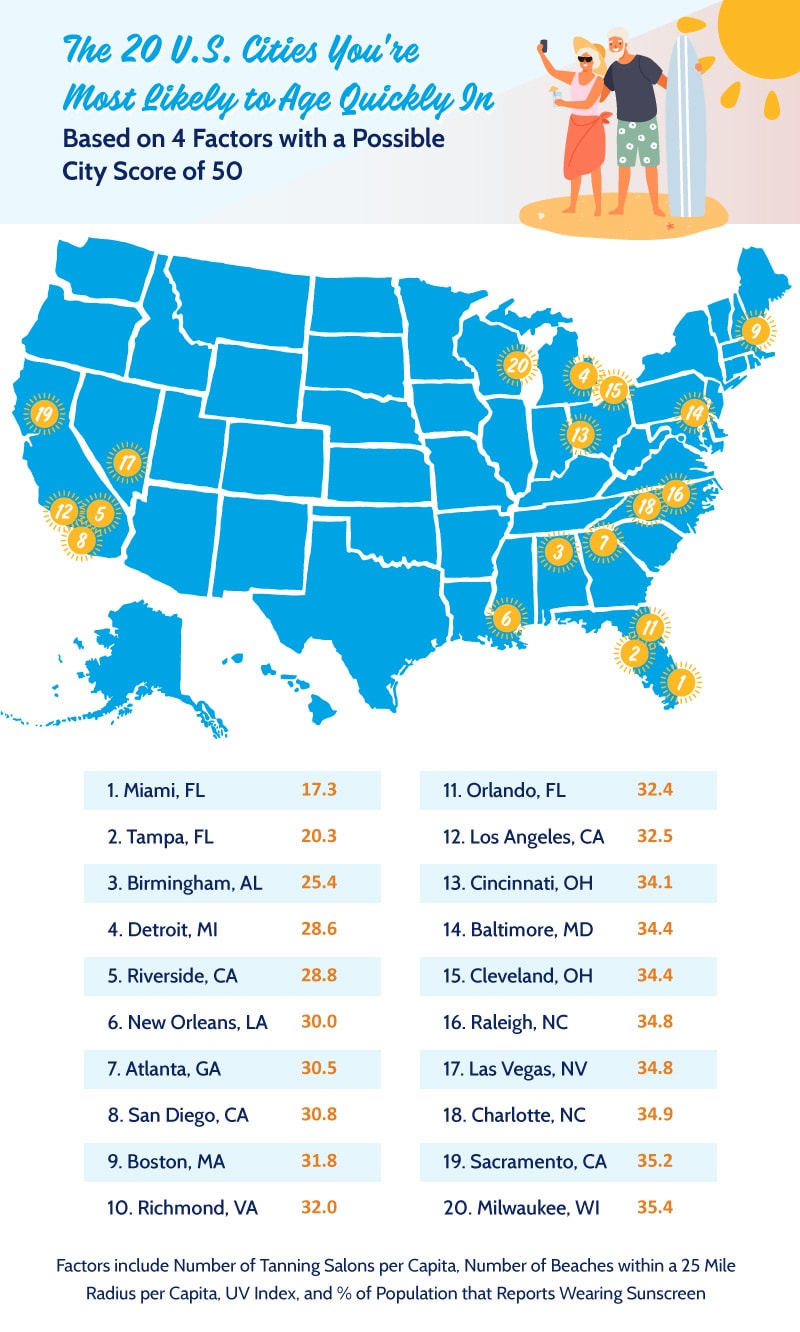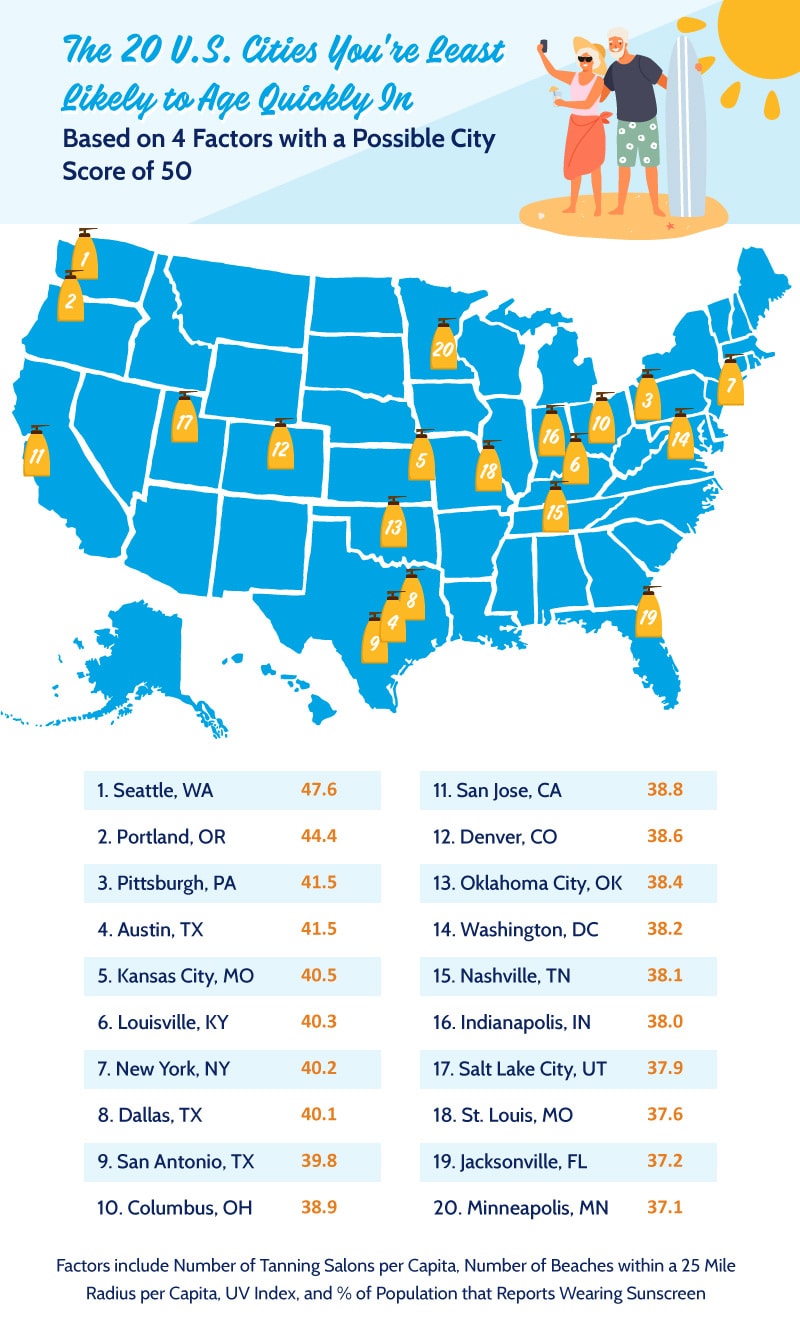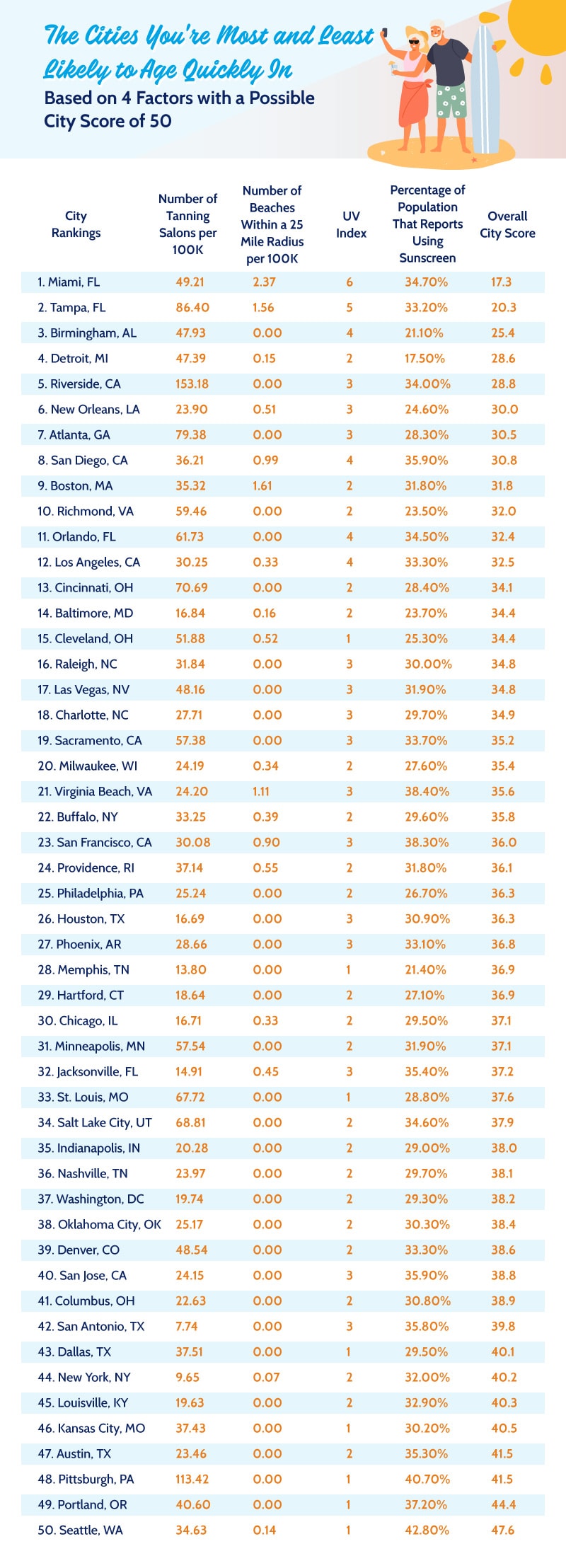Over the last decade, the U.S. has sustained a youth-centric culture that glorifies aging gracefully and strives to prevent premature aging at all costs. Most Americans would much rather appear as if they’ve been drinking from the fountain of youth than appear as if they’re aging before their time. As a result, people have started to use sunscreen and anti-aging skincare at much higher rates, and continuously try to avoid the sun’s harmful rays.
In 2015, the CDC reported in a National Health Interview Survey that 75% of women and 67% of men were using multiple forms of sun protection (i.e. cosmetic with built-in SPF, hat, or umbrella in addition to sunscreen). Meanwhile, the global anti-aging market is projected to reach $217 billion by the end of 2021, according to a recent Zion Market Research Report.
These eye-opening stats prompted those of us at Coventry to question: which locations throughout the U.S. are more conducive to aging? Which regions are more diligent about sunscreen usage? Which citizens have a higher proclivity to age faster based on their city’s UV index? We were determined to find out, so we’ve conducted a data study where we’ve ranked the 50 largest cities in the U.S. in terms of their likeliness to accelerate aging.
Methodology
To determine which cities were the most and least conducive for aging quickly, we looked at four different factors:
1) Number of tanning salons per capita
2) Number of beaches within a 25-mile radius per capita
3) UV index in each city
4) Percentage of the population that reports wearing sunscreen in each city
We assigned weights to each of these four factors based on their level of contribution towards aging quickly. We then calculated the sum of the four weighted factors for each city, which gave us an overall city score for each city. The highest possible city score was 50, meaning that the cities with a score close to 50 are where you’re least likely to age quickly, while cities with a score farthest from 50 are where you’re most likely to age quickly.
The factors are listed below with their respective weights and source data:
- Number of Tanning Salons per Capita
- Weight: 2.0
- Source: Yelp
- Number of Beaches within a 25 Mile Radius per Capita
- Weight: 2.0
- Source: Wikipedia & Google Maps
- UV Index
- Weight: 3.0
- Source: National Weather Service
- Percentage of Population that Reports Wearing Sunscreen
- Weight: 3.0
- Source: City-Data
The Cities You’re Most Likely to Age Quickly In
For those of you looking to prevent premature aging, avoiding Miami Beach is a great place to start. In our study, Miami, FL ranks as the #1 city where you’re most likely to age quickly. While Miami residents’ sunscreen usage is relatively healthy at almost 35%, the city’s UV index (6) is one of the highest in the country and with 11 recreational beaches within a 25-mile radius of the city-center, sun avoidance becomes increasingly difficult.
Tampa, FL ranks second on our list for aging quickly as they have 6 nearby beaches and shockingly 86 tanning salons per capita, with a UV index of 5. Surprisingly, Detroit residents seem to age quicker as well given that only 17% of their population wears sunscreen — the lowest percentage of any city on our list.
Two cities in our top five, Birmingham, AL & Riverside, CA are inland cities with only remote access to beaches. With a UV index of 4, only 21% of Birmingham residents wear sunscreen and there are 48 tanning salons in business per capita. Riverside might be the tanning bed capital of the U.S., with 153 tanning salons per capita. That’s 130% more tanning salons than Los Angeles!
The Cities You’re Least Likely to Age Quickly In
At the other end of the spectrum, residents in the Northwest region age like fine wine. In Seattle, the city where you’re least likely to age quickly, the UV index is 1, there’s only 1 nearby beach, and almost 43% of residents report wearing sunscreen. Portland also has a UV index of 1 and over 37% sunscreen usage.
One might anticipate that Texas residents would age quicker since they’re located so far South, but three cities in Texas landed in our top 10 spots for cities you’re least likely to age quickly in: Austin, Houston, and Dallas. In fact, Houston has a UV index of 3, but 31% of Houston’s population reports wearing sunscreen and there are only 16 tanning beds per capita.
Wrap Up
Overall, this ranking teaches us that aging within a city can’t be dialed down to just one key factor. We can’t assume San Diego, with 14 nearby beaches, is the city most conducive for aging, when their sunscreen usage is through the roof. We also can’t assume that Pittsburgh residents are aging more slowly when there are tanning salons on every corner (113 salons per capita). On the whole, we can safely say that Americans are taking more precaution when it comes to skin protection, tanning, and premature aging than they were 10 years ago.
Americans are also taking more precautions when it comes to planning for retirement. A large part of this is figuring out if they can cash in their term life insurance and how they should be saving and spending their money.
We hope this ranking of U.S cities is found to be helpful, especially for those age-conscious folks deciding where to lay down roots next or even for those deciding where they may want to retire. We would also like to offer our help in determining if you are eligible to sell your life insurance policy and if this would be the right decision for you and your family.





